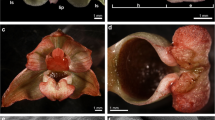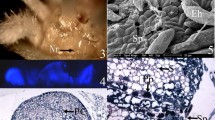Abstract.
Flowers of Prunus persica (L.) Batch. cv. Forastero have an orange toral nectary. The nectariferous tissue was formed by densely packed parenchyma cells (secretory cells) and an epidermis with hairs and modified stomata. The epidermal cells were highly vacuolated with a striated cuticle. The ultrastructure of these cells contained a cytoplasm with endoplasmic reticulum, plastids, mitochondria and dictyosomes. Sub-epidermal cells were barely vacuolated and their ultrastructure was similar to that of the epidermal cells. Differences were observed only in the endoplasmic reticulum, which is organized in a parallel configuration. Plasmodesmata were found between adjacent secretory cells and between secretory and epidermal cells. An electron dense secretion occurred in the intercellular spaces and between the external tangential wall and the cuticle of the epidermal cells. According to the ultrastructural observations, the sugar solution could be passed through the symplast or the apoplast. The nectar could be exuded from the stomata and the micro-channels of the cuticle covering the epidermal cells.
Similar content being viewed by others
Author information
Authors and Affiliations
Additional information
Received July 7, 2002; accepted September 24, 2002 Published online: June 2, 2003
Rights and permissions
About this article
Cite this article
Radice, S., Galati, B. Floral nectary ultrastructure of Prunus persica (L.) Batch cv. Forastero (Newcomer), an Argentine peach. Plant Syst Evol 238, 23–32 (2003). https://doi.org/10.1007/s00606-002-0279-9
Published:
Issue Date:
DOI: https://doi.org/10.1007/s00606-002-0279-9




